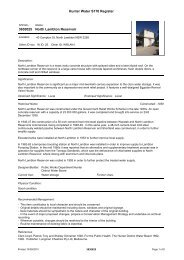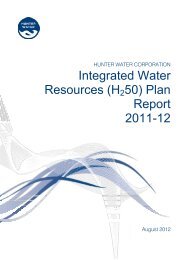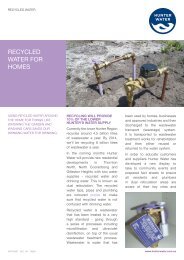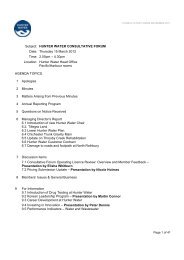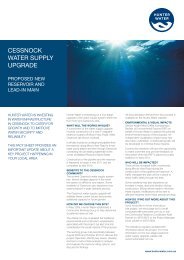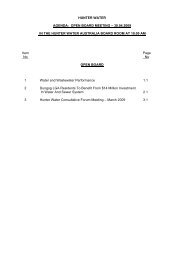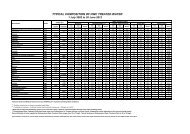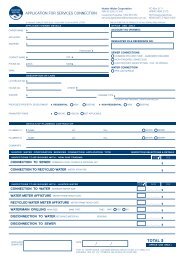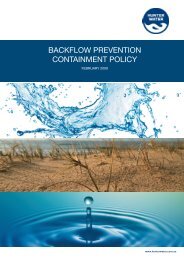Catchment Management Plan - Hunter Water
Catchment Management Plan - Hunter Water
Catchment Management Plan - Hunter Water
You also want an ePaper? Increase the reach of your titles
YUMPU automatically turns print PDFs into web optimized ePapers that Google loves.
as it provides multiple environmentalbenefits. We have greatest influenceover freehold land and on public landsadministered by NSW Governmentagencies, which together cover aboutone third of the catchment area. <strong>Hunter</strong><strong>Water</strong> has been working with otheragencies to develop NSW Governmentwide objectives, strategies anddirections for managing public landto combat climate change 3 . Prioritymitigation strategies relevant to <strong>Hunter</strong><strong>Water</strong>’s catchments include:• increasing carbon sequestrationcapacity, especially on vacant ordegraded land and• reducing greenhouse gas emissionsfrom land management activities.2. Climate change adaptation incatchments<strong>Management</strong> of catchments for waterquality and quantity needs to beresilient and responsive to changes tothe biophysical environment arisingfrom climate change. Implementing aregularly updated catchment plan thatis based on scientific observation allows<strong>Hunter</strong> <strong>Water</strong> the ability to respondto environmental change. Effectiveplanning in catchments for water qualityin many ways overlaps with planning forclimate change adaptation.• Adaptation through collaborationand innovation:For appropriate planning to occur, thereis a need for a collaborative approachacross geographical boundaries andlevels of government. People must finddifferent solutions through innovativeapproaches. <strong>Hunter</strong> <strong>Water</strong> understandsthat building and sharing knowledgeis cornerstone to effective planning,whether it be land use planning for waterquality or climate change.• Adaptation to increased stormintensity:In its National Climate ChangeAdaptation Framework 4 , COAGrecognised that a change in the patternof Australia’s rainfall due to climatechange presents one of the mostsignificant challenges to Australiangovernments. More concentratedrainfall events have human healthimplications through the increased transportof human disease due to wastewateroverflows. Higher peaks can mobilise soilsby erosion, thereby reducing water qualityand increasing treatment cost. <strong>Hunter</strong> <strong>Water</strong>recognises that it has an important role inmaintaining the quality of its source waterthrough proactive catchment planning.• Adaptation to broad scale changes invegetation:The predicted change in distribution ofvegetation communities may have animpact on the natural filtration of water.There is potentially an increased frequencyof algal bloom in rivers and dams dueto reduced natural nutrient attenuation.<strong>Hunter</strong> <strong>Water</strong>’s catchments cover a diversetopographic and wide spatial area. Thecatchments have a diversity of climates andsoil landscapes. <strong>Catchment</strong> activities thatimprove riparian vegetation may increasethe resilience of flora and fauna to climatechange by allowing migration of plants andanimals to favourable areas.• Adaptation to increased bushfirefrequency and intensity:Under some climate change scenarios,increased bush fire frequency andintensity results in loss of vegetationand subsequent reduction in waterquality. More intense fires may reducethe ability to use particular sourcewaters or necessitate additional watertreatment capability. Using <strong>Hunter</strong><strong>Water</strong>’s Enterprise Risk <strong>Management</strong>Framework, bushfire preparednessis the priority risk to <strong>Hunter</strong> <strong>Water</strong>from climate change. Part 3 of thisdocument outlines how <strong>Hunter</strong> <strong>Water</strong>will produce a Bushfire <strong>Management</strong><strong>Plan</strong> that will be updated withreference to climatic conditions.3 NSW public land and climate change 2010-2015, NSW Government4 Council of Australian Governments National Climate Change Adaptation Framework – endorsed 2007CATCHMENT MANAGEMENT PLAN . ssS . 001 . JUNE20109




